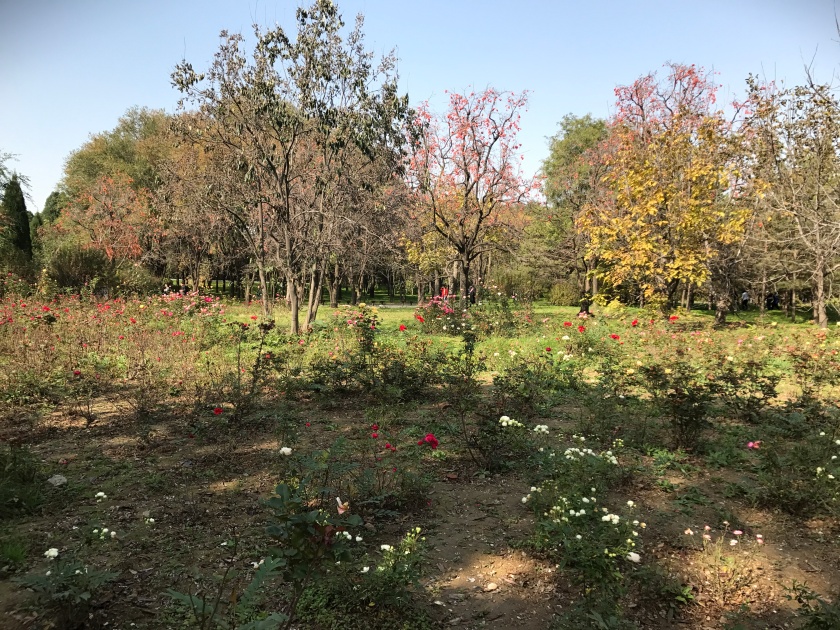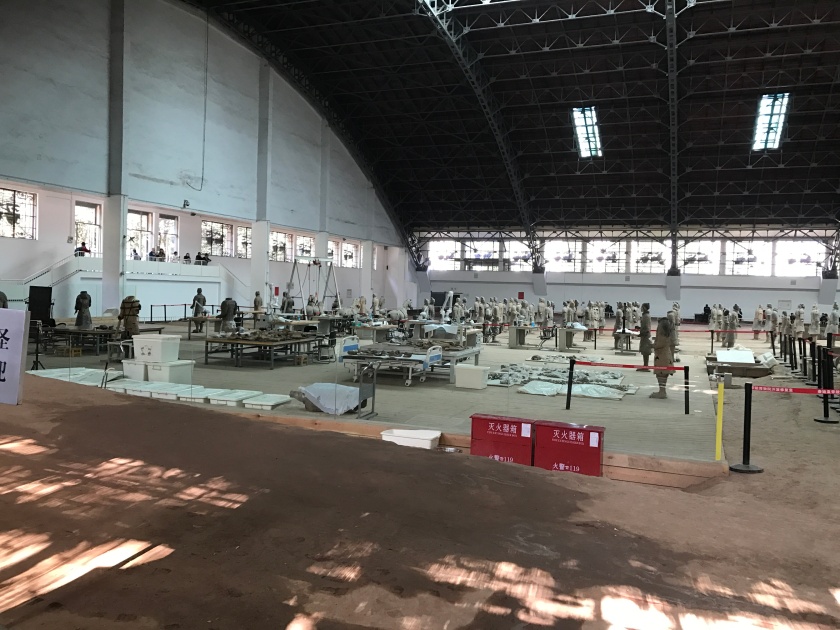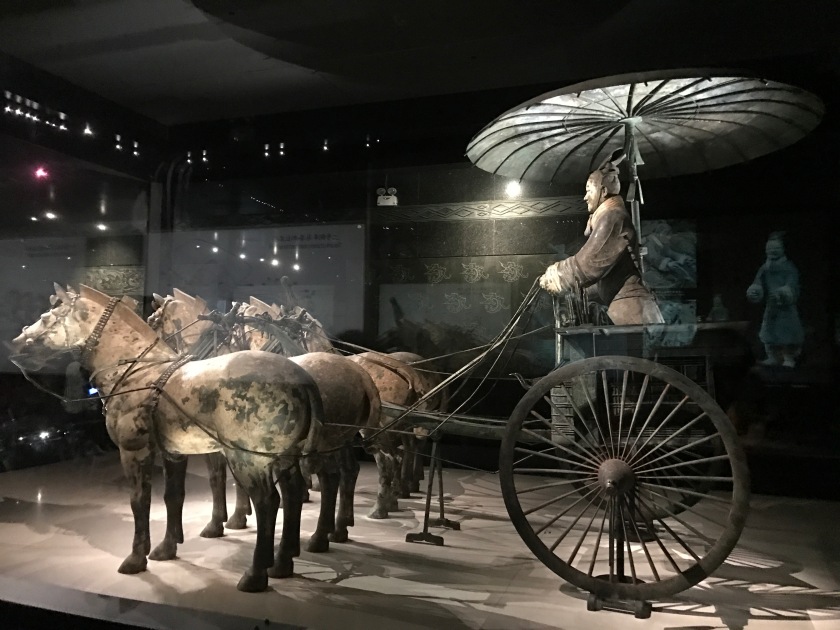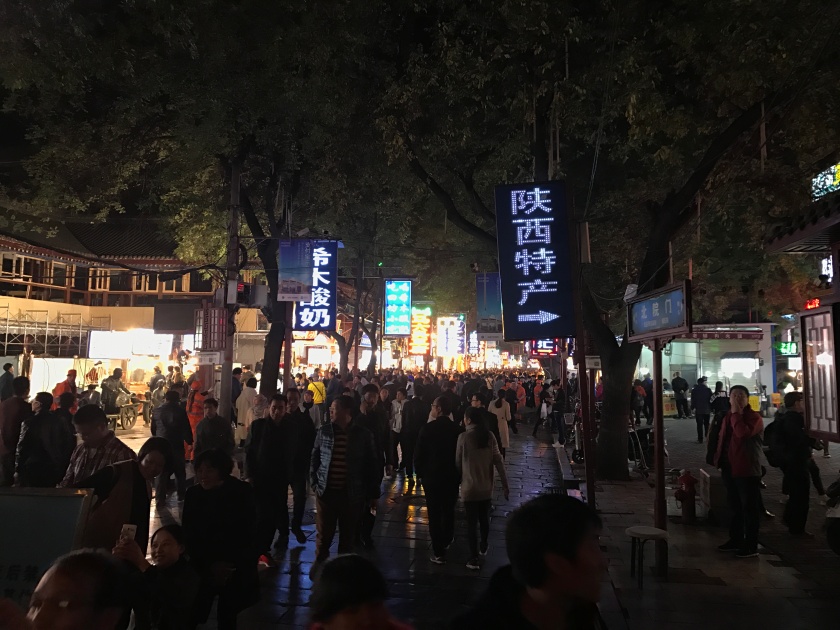Our time in Xian began when we arrived on the overnight sleeper train from Xian. It was Day 4 of our week-long trip to China. (Read about Day 1, Day 2 and Day 3). Our guide from The China Travel Company picked us up from the train station. The drive to the hotel from the station took about 20 minutes, most of it in the rush hour traffic.
Our hotel, the Citadine Central apart-hotel was inside the Xian city walls, close to the drum tower and very central. The hotel, as the name implies was an apartment hotel – with a bedroom, kitchen, bathroom and sitting room. We had booked an early check-in at the hotel and we had a quick break to freshen up and have some breakfast. (Sleeper trains are great, except for the mornings. The limited facilities make it difficult to properly wake up).
Then we set off to see the main attraction of the day – the Qin Tomb Terracotta Warriors and Horses. Considered one of the greatest archaeological sites in the world, it is about 45 km outside Xian. The journey from Xian took about an hour, and took us through the fast developing Xian and its subburbs.

Terracotta Warriors
Much has been written about the Terracotta Warriors, so I will only do a brief summary here. The Terracotta Army – thousands of life-sized Terracotta Warrior figures was built to accompany the first emperor of China into the afterlife. The first emperor of China was prince Ying Zheng who came to the throne in 246 B.C. at the age of 13. He unified China in 221 B.C. and took the name of Qin Shi Huang Di (meaning “the First Emperor of Qin”). Emperor Qin also built the first Great Wall of China.
After the tickets and the entrance, you walk through a beautiful park to enter the main museum area. In the past all of this used to be fields around the tomb.

The museum consists of 3 archaeological pits and 1 museum.

Pit 1 is the largest and appears in most photographs associated with the Terracotta army. The pit is about 200 meters long and 62 meters wide, and with the arching roof looks a bit like an aircraft hangar.

Pit 1 is 4 to 6 meters deep and has over a thousand Terracotta warrior figures, representing the foot soldiers of emperor Qin’s army. There are rows and rows of warriors, all standing facing East in front of the emperor Qin’s tomb. Each figure is unique and intricately detailed; with different hairstyles (indication of status in ancient China), suits of armour, shoes and facial expressions.

There are about 2000 reconstructed warrior figures on display, but it is estimated there are over 6000 warriors in this pit in total, most of it still to be recovered. At the back of pit 1, you can see some of the archaeological work ongoing to recover the remaining warriors.


Next, we headed to Pit 2, which contains the battle array of the emperor’s army. It has rows of kneeling and standing archers, chariots and troopers holding weapons.

At Pit 2, there are several Terracotta figures places in glass cases, so you can get a closer look at them. These included a general, standing archer, kneeling archer and a horseman. The up close view gives you a chance to take in the detail and colours of the figures. The figure of the kneeling archer was the only figure in the entire terracotta army to be recovers completely intact. This is thought to be because it was in a kneeling position, it was protected by the falling debris from the taller figures that surrounded it.
Pit 3 is smaller than the first two, and contains the command centre for army in Pits 1 and 2. The figures are placed differently – facing each other as if they were in war room discussions (as opposed to battle formations in the other pits).
One section of Pit 3 is left as it was originally discovered, with the Terracotta figures in hundreds (if not thousands) of pieces, lying scattered all over. This was a great eye opener as it revealed the amount of work gone into re-assembling the figures that are currently on display.

Last, but not the least, the exhibition displays two bronze chariots, completed with horses, built to 1/3 scale. It also has bronze weapons found around the tomb and information about the discovery of the Terracotta warriors and the work gone into assemble the figures.

The Terracotta warriors are every bit as impressive as you expect them to be. However, what I found most fascinating is the fact that, what has been discovered to date is only a fraction of what is yet to be uncovered. The Qin emperor’s tomb is 1.5km from the Terracotta warrior site and it is believed that all of this area is filled with the full complement of staff to serve the emperor in the afterlife. A small number of terracotta and bronze figures of acrobats, civil officials, dancers and animals have so far been discovered.
The other surprising fact is that the main reason that all the figures are not excavated to date is because they cannot be preserved. Even with today’s technology, an effective method to preserve the colours of the statues is yet to be found.

The Qin emperor’s tomb is yet to be excavated too. Given the scale of the Terracotta Warriors, one can only imagine what the Qin emperor’s tomb contains. According to legend, it contains rivers of gold and mercury flowing through it and many other priceless artefacts.
It is believed that the warriors were built by a 700,000 strong labour-force and took 40 years to complete. Another a little known fact is that, 4 years after completion (and the emperor’s death) there was a slave rebellion and the Terracotta army was set on fire. The scorch marks from this fire can still be seen today in Pits 1 and 2.
After a couple of hours at the terracotta warriors museum, we decided to head back to Xian. The exit from the museum is built through a souvenier shop area.
The Terracotta Army remained untouched underground for more than 2,200 years and was discovered by local farmers who were digging a well in 1974 in Xian. In one of the shops here, you can meet one of the farmers who discovered the Terracotta warriors in 1974. We bought a book about the discovery of the warriors written by him and he autographed it for us, complete with the farmers seal and the emperor’s seal.
You can also visit the nearby mausoleum of Emperor Qin, but we did not have time to visit this. We were able to catch a glimpse of the mausoleum as we headed back to Xian.

Tip: Visiting the Terracotta warriors is a half a day trip, but extend this to a one day trip and visit the Qin mausoleum and the nearby Huaqing Hot Spring and the Lishan Forest park. Spending this extra half day will give you a much more complete story about emperor Qin and how the Terracotta Warriors were built.
Xian City Walls
Back in Xian, we decided to take a walk on the city walls. The walls were built by Zhu Yuanzhang, the first Emperor of the Ming Dynasty in the late 1300s.

The wall is 14m wide at the top, and 18m wide at bottom and 14 km in total length. Outside the walls is a moat and a strip of park land, surrounding it all the way.


Each side of the wall has watchtowers and gates positioned at strategic intervals. The distance between two watchtowers is equivalent to the distance of two arrow flying.

We decided to walk from the city wall East gate to the South gate, a distance of 3 km. On the way, we stopped to look inside one of the watch towers.



During the walk, we had time to find out more about modern-day Xian from our guide. Surprisingly, property prices inside the city walls, although central, are cheaper than outside the city walls. This is because of the traffic. Property outside the walls are more sought after as there is less traffic and lots of green spaces.

After going back to the hotel for a brief rest (the previous night on the sleeper train was catching up) we headed out to explore Xian’s Muslim quarter and street food.
The Muslim Quarter is behind the Drum Tower, which was beautifully lit up at night.


The Huimin street with its lights, smells and food takes over your senses completely. There are a wide array of food in all the outlets.

After filling up with street food, we walked through the centre of Xian, to take in the Bell Tower, which was also beautifully lit up against the night sky, before calling it a day.


Reflections: It was another packed day in our week in China. The Terracotta Warriors were truly magnificent. In hindsight, it would have been better to spend a whole day to visit the Terracotta warriors and Qin mausoleum and Lishan forest park. Tomorrow we will be heading out to Shanghai on the high-speed train.









Amazing! I can’t believe they have only discovered a fraction of them. How neat you got to meet one of the people that discovered them. When I go I will definitely take your advice and make it a full day trip. Thanks for sharing on #TheWeeklyPostcard.
LikeLiked by 1 person
I know! So much more to see…
LikeLike
I think the Terracotta warriors are so impressive. I really want to see them someday. #TheWeeklyPostcard
LikeLiked by 2 people
Yes, they are well worth a visit.
LikeLike
The Terracotta Warriors are so fascinating and I can’t believe only a fraction has been reconstructed! I watched an interesting documentary on them and how the color just dissolves into dust within minutes of being exposed to fresh air. Hope they can find a way one day! Thanks for sharing on #TheWeeklyPostcard!
LikeLiked by 1 person
Yes, so mind blowing when you are there! Thanks for stopping by 🙂
LikeLike
What a great post! I’ve always wanted to see the Terracotta Army in person; it’s one of those human enterprises that defies the imagination, such a massive amount of time and manpower. It’s beautiful that even as China’s population explodes, the past is still revered within these thriving metropolises. Cities in the US on so many occasions have squandered and bulldozed so much of our short past. How many walked those city walls? It’s just so cool! The drum tower looks amazing as well. Thanks for sharing on #TheWeeklyPostcard!
LikeLiked by 1 person
Thank you!
LikeLiked by 1 person